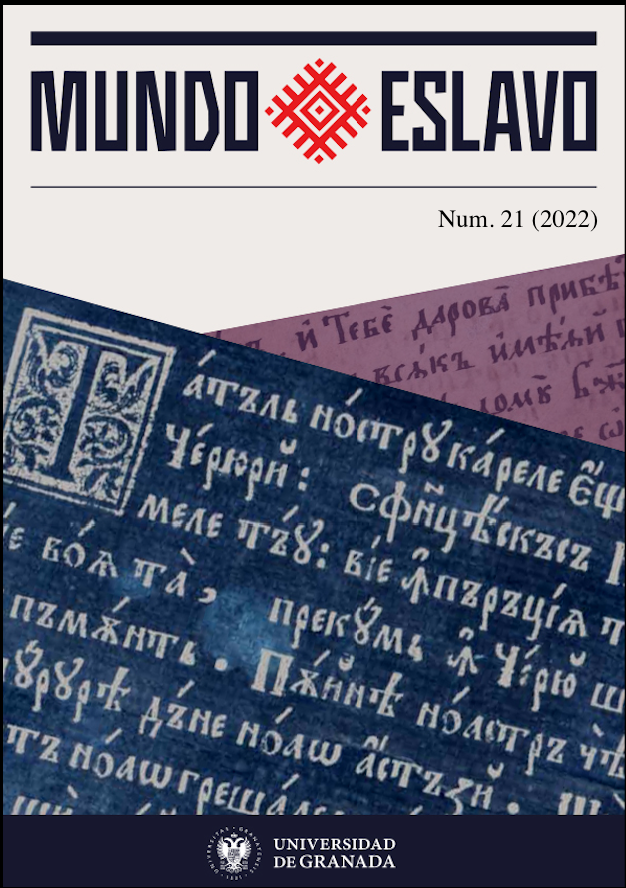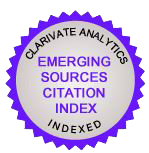Imagen de la luz en la poesía de Olga Sedakova
DOI:
https://doi.org/10.30827/meslav.vi21.25160Resumen
The article examines the features of the implementation of the image of light in the poetry of Olga Sedakova. The analysis is devoted to understanding of the lexeme “light” functioning in poetic texts and supported by the research on cognitive, semantic and cultural structures the image of light carries. The research carried out makes it possible to expand the understanding of Olga Sedakova's work, supplement the existing materials on poetic paradigms, and continue researching the Russian poetic language based on formal signs and interlinks with European texts, in particular, with the metaphysical poetry and religious thought. The research offers insights on the unique style and imagery of Olga Sedakova which supports poetry as a transgression from the main, well-known specifics of light as a concept. As a result, the research is based on a generic philological, as well as interdisciplinary approach. The results of the study allow us to propose the solidity of the motive of light as semantically accented, used both as vision-derived experience and a sign requiring philosophical interpretations. Dialectics of dichotomies connected with Light in Olga Sedakova’s works show not only the interdependent dynamics, but also the endeavour for creating a liminal space out of oppositions’ confrontation. The nature of this synthesis allows us to connect the author’s poetic texts with the neo-baroque stylistics.
Descargas
Citas
Blok, A. A. (1999). Polnoe sobranie sočinenij i pisem (Complete Collection of Works and Letters). A. L. Grišunin et al., Compil., Vol. 5: Poetry and Poems (1917-1921). Moscow: Science.
Calma, C. E. (2010). Symbolism of Light and Darkness in Selected Prose and Poetry of John Donne. In M. Coghen, Z. Mazur, & B. Piątek (Eds.), Ambiguity and the search for meaning: English and American studies at the beginning of the 21st Century (Vol. 1: Literature, pp. 99–108). Kraków: Jagiellonian University Press.
Čulig, J. (2019). Light as a visual source domain for the divine in the 17th century painting. Jezikoslovlje, 20(2), 303–324.Danaher, D. S. (1995). Tolstoy’s use of light and dark imagery in the death of Ivan Il’ic. The Slavic and East European Journal, 39(2), 227–240. doi:10.2307/309375
Erofeeva, I., Gilyazov, A., & Pilgun, M. (2019). Light as a Significant Concept of Medieval Religious Consciousness. Journal of Research in Applied Linguistics, 10, 927–935. doi:10.22055/RALS.2019.15168
Gigante, J. (2018). Variacii na temy sveta i t`my v poe`zii Eleny Shvarc (Variations on themes of light and darkness in the poetry of Elena Schwartz). Literatūra, 60(2), 68–75. doi:10.15388/Litera.2018.2.12032
Grominová, A. (2019). The Motif of World Transfiguration in Ivan Zhdanov’s Poem Orans. Quaestio Rossica, 7.3, 983–991.
Kolmakova O. A. (2016). Motiv sveta v sbornike S. A. Nesterovoy «Utrenniy svet» (Motive of light in the collection of S. A. Nesterova “Morning light”). Bulletin of BSU. Language, literature, culture, (3), 49–53.
Leahy, R. (2018). ‘With, all down darkness wide, his wading light?’: Light and dark in Gerard Manley Hopkins’s ‘The Candle Indoors’ and ‘The Lantern out of Doors. Nordic Journal of English Studies, 17(1), 135–151.
Mead, G. R. S. (Ed.). (1895). Select Works of Plotinus. G. Bell and sons.
Melnikova N. N. (2013). Lokusy greha v russkoy literature XIX – nachala XX v. (semantika sveta i t`my) (Loci of sin in Russian literature of the XIX – early XX century (semantics of light and darkness)). Bulletin of the Russian State University for the Humanities. Series: Literary criticism. Linguistics. Culturology, 20(121), 45–51.
Pavlovich N. V. (1991). Paradigmy obrazov v russkom poe`ticheskom yazyke (Paradigms of images in the Russian poetic language). Questions of linguistics, (3), 104–117.
Pavlovich, N. V. (1999). Slovarʹ poėticheskikh Obrazov: Na materiale russkoĭ khudozhestvennoĭ literatury XVIII–XX vekov (Dictionary of poetic images. Based on the material of Russian fiction of the 18th – 20th centuries). Vol. 2. Moscow: Editorial URSS.
Reece, W. D. (1989). The concept of Light in the old testament: A semantic analysis. Doctoral dissertation. Los Angeles, IL: University of California.Regan, S. (2016). Lux Perpetua: The Poetry of Seamus Heaney, from Door into the Dark to Electric Light. Romanticism, 22(3), 322–330. doi:10.3366/rom.2016.0293
Sedakova O. A. (1994). Stihi (Poems). Moscow: “Gnosis”, “Carte Blanche”.
Sedakova O. A. (2005). Cerkovnoslavyano-russkie paronimy: Materialy k slovaryu (Church Slavonic-Russian paronyms: Materials for the dictionary). Moscow: Greco-Latin office of Yu. A. Shichalina.
Sedakova O. A. (2010). Chety`re toma. Tom II. Perevody` (The Four Volumes. The Second Volume. Translations). Moscow: Russian Foundation for the Promotion of Education and Science.
Sedakova, O. A., & Krimmel’, M. (n.d.). Ольга Седакова. Retrieved June 17, 2022, from http://www.olgasedakova.com/
Skorov, P. (2005). Motifs of Light in Pushkin’s Poetry: A Perspective on the Poet’s Worldview. The Slavonic and East European Review, 83(4), 573–598.
Spivakova E. M. (2020). Svet v mire «Stihov o Prekrasnoy Dame» (Light in the world of “Poems about the Beautiful Lady”). Philological sciences. Questions of theory and practice. 13(2), 130–134. doi:10.30853/filnauki.2020.2.25
Tsur, R. (1998). Light, fire, prison: A cognitive analysis of religious imagery in poetry. Psyart — A Hyperlink e-journal, 2. Retrieved June 17, 2022, from https://web-archive.southampton.ac.uk/cogprints.org/742/1/Light_Fire_Prison.html
Zavarkina, M. V., Khramikh, A. V. (2015). Motiv sveta v rasskaze B. Zayceva «Osenniy svet». Problemy istoricheskoy poe`tiki [The motive of light in B. Zaitsev’s story “Autumn Light”]. Problems of Historical Poetics, (13), 647–659.
Descargas
Publicado
Cómo citar
Número
Sección
Licencia
Derechos de autor 2023 Mundo Eslavo

Esta obra está bajo una licencia internacional Creative Commons Atribución-NoComercial-CompartirIgual 4.0.
Los autores conservan los derechos de autor sobre sus trabajos y garantizan a la revista el derecho de ser la primera publicación del mismo. Los artículos se publican bajo la licencia Creative Commons Atribución-NoComercial 4.0 Internacional (CC BY-NC-SA 4.0), lo que permite a los lectores y otros investigadores copiar, redistribuir, remezclar, transformar y construir a partir del material, siempre que se respeten las condiciones establecidas.













